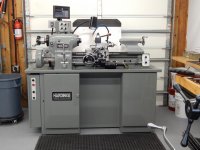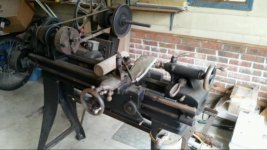Tenn_blue59
Plastic
- Joined
- Jan 20, 2011
- Location
- Tennessee
Got the Hendey off the trailer and into the garage, and have started to clean it up. Lets just say that it has a "fine patina" of old oil/grease, chips, and dirt on it. Seems to run ok, but not the cleanest thing around! Which brings me to my question; Whats the best way to clean up a dirty lathe?
Guessing a pressure washer would not be a good idea... I started off with some mineral spirits and an old brush. Was gonna use a rag, but all those chips make that seem like a bad idea on the hands. My "plan" is to do a couple mineral spirit wipedowns, then use a degreaser on the painted surfaces, sand and repaint as needed to get a decent finish - not gonna be a show piece, but I want it to look good and protect the metal...
As for the machined surfaces, was going to use scotchbrite to clean them up, then add a light coat of oil to protect them.
Once its clean, I'll flush and refill all the fluids, replace felts, etc.
Anybody have a better method?
Guessing a pressure washer would not be a good idea... I started off with some mineral spirits and an old brush. Was gonna use a rag, but all those chips make that seem like a bad idea on the hands. My "plan" is to do a couple mineral spirit wipedowns, then use a degreaser on the painted surfaces, sand and repaint as needed to get a decent finish - not gonna be a show piece, but I want it to look good and protect the metal...
As for the machined surfaces, was going to use scotchbrite to clean them up, then add a light coat of oil to protect them.
Once its clean, I'll flush and refill all the fluids, replace felts, etc.
Anybody have a better method?


 . I then finish cleaning/drying parts and lubricate them and spray surfaces with WD-40.
. I then finish cleaning/drying parts and lubricate them and spray surfaces with WD-40. 


